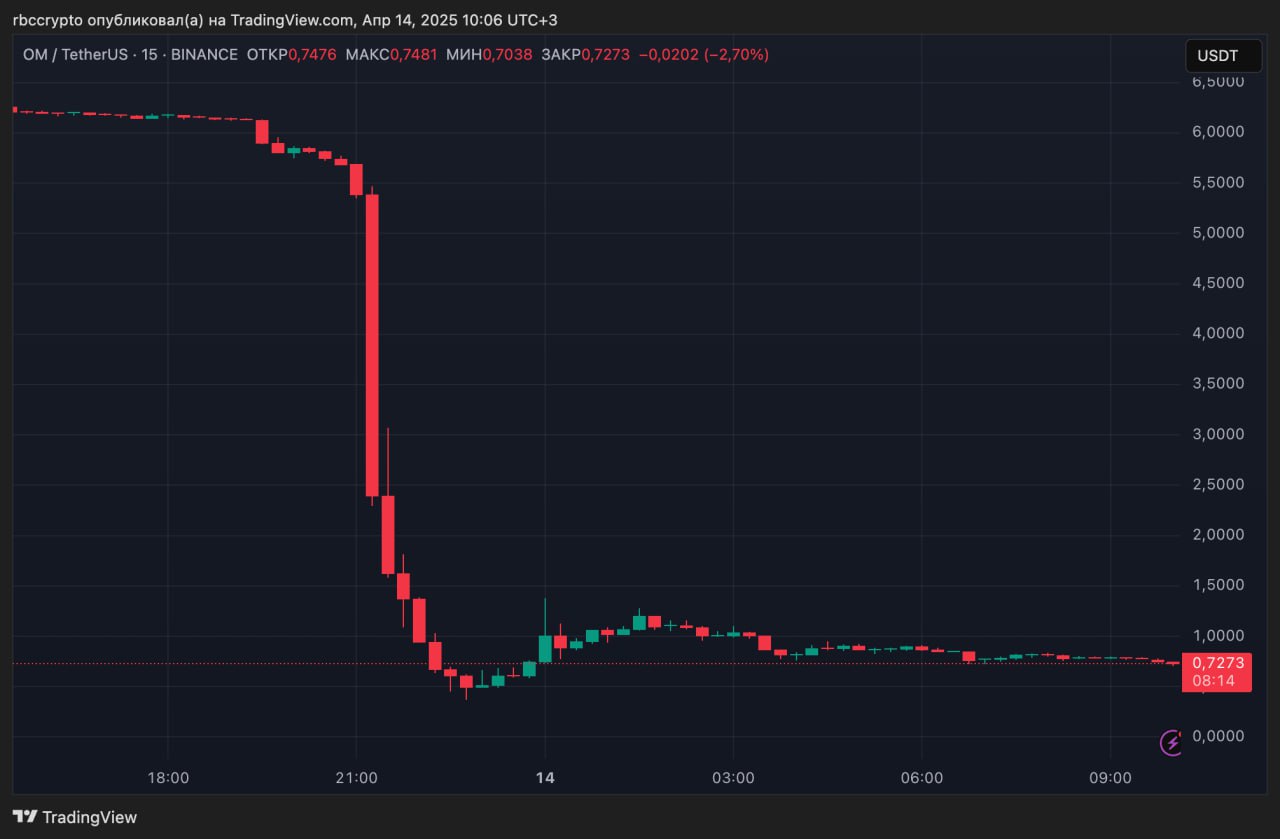Hello!
On April 13, 2025, the cryptocurrency market witnessed a seismic event: the Mantra (OM) token, native to a blockchain focused on tokenizing real-world assets, plummeted by over 90% in mere hours, erasing billions in market capitalization.
 From a high of $6.30, the token crashed to below $0.50, leaving investors reeling and sparking heated debates about the stability of the crypto ecosystem.
From a high of $6.30, the token crashed to below $0.50, leaving investors reeling and sparking heated debates about the stability of the crypto ecosystem.
While the Mantra team attributed the collapse to "reckless liquidations" and denied insider involvement, this dramatic fall may be more than an isolated incident—it could be the first sign of a broader wave of token crashes looming on the horizon.
Also read:
- Crypto Exchanges: A Colossus with Feet of Clay - Fake Volumes, Fake Traffic, and Fake Users Introduction
- The Crypto Market: "No Matter How You Move, The Cow is Dead"
The OM Token Collapse: What Happened?
 The OM token’s rapid descent was both shocking and perplexing. Initial reports pointed to a wallet, allegedly linked to the Mantra team, depositing 3.9 million OM tokens onto the OKX exchange, raising fears of a massive sell-off.
The OM token’s rapid descent was both shocking and perplexing. Initial reports pointed to a wallet, allegedly linked to the Mantra team, depositing 3.9 million OM tokens onto the OKX exchange, raising fears of a massive sell-off.
Given that the team reportedly controls nearly 90% of the token’s supply, such a move could easily destabilize the market. This triggered a cascade of panic selling, stop-loss activations, and liquidations of leveraged positions, obliterating over $5.5 billion in value in under an hour.
Mantra’s co-founder, John Patrick Mullin, quickly refuted claims of a "rug pull," asserting that the crash stemmed from forced liquidations by centralized exchanges, not team actions. He emphasized that the team’s tokens remain locked and that Mantra’s fundamentals are strong.
Yet, skepticism persists. Allegations of over-the-counter (OTC) deals at steep discounts and a controversial airdrop incident in March — where over 50% of eligible wallets were blacklisted without explanation — have fueled distrust within the community.
On topic:
- The Inevitable Burst of the Crypto Bubble: What Needs to Happen?
- The Cryptocurrencies, Meme Coins, and the "Dead Cat Bounce" Phenomenon in 2025
A Symptom of a Larger Problem
The OM token’s collapse is not an anomaly but a symptom of deeper vulnerabilities in the crypto market.
 Several factors suggest that this could be the first of many such implosions:
Several factors suggest that this could be the first of many such implosions:
- Over-Centralization of Token Supply: Many projects, like Mantra, have teams or insiders controlling large portions of the token supply. This centralization creates a ticking time bomb—any significant sell-off, whether intentional or forced, can trigger catastrophic price drops. The OM crash highlights how fragile investor confidence can be when transparency is lacking.
- Speculative Hype and Overvaluation: The crypto market thrives on hype, often inflating token prices far beyond their intrinsic value. Mantra’s $6 billion market cap before the crash was driven by excitement around real-world asset tokenization, including a high-profile $1 billion deal with DAMAC. However, speculative bubbles are prone to bursting, especially when projects fail to deliver tangible results or face market shocks.
- Leverage and Liquidation Risks: The OM collapse was exacerbated by leveraged positions being wiped out in a chain reaction. High leverage is common in crypto trading, amplifying both gains and losses. When prices dip, automated liquidations on centralized exchanges can spiral out of control, as seen in this case.
- Regulatory and Market Pressures: The crypto space is under increasing scrutiny. Regulatory crackdowns, cybersecurity threats (like the $1.4 billion Bybit hack earlier in 2025), and macroeconomic shifts are creating a volatile environment. Projects with weak fundamentals or questionable practices are particularly vulnerable.
Thousands More to Follow?
The OM token’s crash may be a harbinger of a broader reckoning. The crypto market is saturated with thousands of tokens, many of which lack real utility, robust governance, or sustainable economics.
 Here’s why we could see a wave of similar collapses:
Here’s why we could see a wave of similar collapses:
- Market Saturation: With over 10,000 cryptocurrencies listed on platforms like CoinMarketCap, many are little more than speculative experiments. Projects with weak fundamentals or duplicated use cases are unlikely to survive in a competitive landscape, especially during market downturns.
- Eroding Trust: High-profile failures like Terra’s LUNA in 2022, FTX, and now OM erode investor confidence. Each collapse fuels skepticism, reducing liquidity and making smaller tokens more susceptible to panic-driven sell-offs.
- Economic Headwinds: Rising interest rates and global economic uncertainty are drying up speculative capital. Investors are becoming more risk-averse, pulling funds from high-risk assets like altcoins. Tokens without strong backing or adoption could face existential threats.
- Technological and Security Risks: The crypto ecosystem is plagued by hacks, exploits, and protocol vulnerabilities. A single breach or failure can wipe out a token’s value overnight, as seen in past incidents like the Libra memecoin implosion.
On topic: At What Bitcoin Level Will Whales Trigger Forced Liquidations?
Lessons and the Path Forward
 The OM token’s collapse serves as a stark reminder of the risks inherent in the crypto market. For investors, due diligence is paramount—researching tokenomics, team credibility, and market dynamics can help avoid catastrophic losses. Diversification and avoiding over-leveraged positions are also critical to weathering volatility.
The OM token’s collapse serves as a stark reminder of the risks inherent in the crypto market. For investors, due diligence is paramount—researching tokenomics, team credibility, and market dynamics can help avoid catastrophic losses. Diversification and avoiding over-leveraged positions are also critical to weathering volatility.
For projects, transparency and decentralization are non-negotiable. Centralized control over token supply, opaque governance, or reliance on hype over substance invites disaster. Building sustainable value through real-world adoption and robust technology is the only way to endure market cycles.
Regulators, too, have a role to play. While heavy-handed regulation could stifle innovation, clear guidelines on transparency, investor protection, and exchange practices could stabilize the market and weed out bad actors.
Conclusion
The 90% collapse of the OM token is more than a cautionary tale—it’s a warning of what’s to come. As the crypto market matures, the chaff will be separated from the wheat.
Thousands of tokens, propped up by speculation rather than substance, may face similar fates. While the promise of blockchain technology remains transformative, only projects with genuine utility and resilience will survive the coming storm.
For now, the OM crash is a wake-up call: tread carefully, or risk being swept away in the next wave of failures.
Thank you!
Subscribe to our newsletter! Join us on social networks!
See you!






